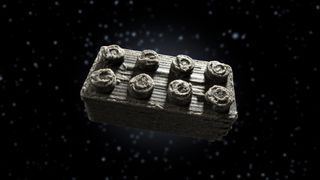
Shipping things to the moon is expensive, and even after astronauts begin walking on the moon again, that isn't going to change. Every additional gram of cargo sent to the moon is another gram that must be lifted into space against the brunt of Earth's gravity. Thus, every gram of material future lunar denizens can take from the moon itself is one gram less of a burden.
This dilemma is especially prominent when it comes to building future lunar habitats. Of course, we aren't sure how building with moon materials will actually work; on Earth, we have virtually no practice doing it. However, lately, scientists from the European Space Agency (ESA) have begun toying with a very interesting idea. They've tried, for a start, fashioning space dust into LEGO-like bricks and building with them.
"Nobody has built a structure on the moon, so it was great to have the flexibility to try out all kinds of designs and building techniques with our space bricks,” said Aidan Cowley, ESA Science Officer, in a statement.
There is a slight catch: ESA's space bricks aren’t actually fashioned from moondust. For all the lunar samples that various missions have returned to Earth, lunar regolith is simply too scarce and scientifically valuable to use for bricks. Instead, ESA scientists turned to a simulant: regolith from a meteorite. Specifically, according to the BBC, scientists used 4.5-billion-year-old material from a meteorite discovered in Northwest Africa around the year 2000. Using a 3D printer, they fashioned the meteorite dust into bricks shaped like classic 2x4 LEGOs.
Related: 'ESA Space Bricks' landing at Lego Stores could help build real Artemis moon base
The resultant bricks are not entirely like LEGOs — they are significantly rougher, for one — but they're recognizable enough. They can stack just like LEGOs can, and builders can assemble them into different structures. They're similarly exciting to play with, but also able to help scientists test construction methods and determine which ones might work best with the material at hand.
"It was both fun and useful in scientifically understanding the boundaries of these techniques," said Cowley in the statement.
Get the Space.com Newsletter
Breaking space news, the latest updates on rocket launches, skywatching events and more!
ESA's moon-bricks will also be on display to the public at select LEGO stores between June 20 and Sept. 20.
Join our Space Forums to keep talking space on the latest missions, night sky and more! And if you have a news tip, correction or comment, let us know at: community@space.com.

Rahul Rao is a graduate of New York University's SHERP and a freelance science writer, regularly covering physics, space, and infrastructure. His work has appeared in Gizmodo, Popular Science, Inverse, IEEE Spectrum, and Continuum. He enjoys riding trains for fun, and he has seen every surviving episode of Doctor Who. He holds a masters degree in science writing from New York University's Science, Health and Environmental Reporting Program (SHERP) and earned a bachelors degree from Vanderbilt University, where he studied English and physics.
-
Unclear Engineer I am thinking that there is a better approach to making regolith bricks on the Moon.Reply
First, if I were designing a Moon building, I would be thinking about 4 issues:
1. Air tightness
2. Protection from meteorites
3. Protection from radiation
4. Thermal insulation
For leak tightness, I think fabricating something on Earth is going to be more reliable than trying to fabricate it on the Moon, So, I would be looking at the technology being developed already for "inflatable" space station satellites. The air locks, walls, etc. would be made on Earth and transported to the Moon as one piece or as large modules with engineered interconnections
But, an inflatable building is likely to get perforated by meteorites, so it needs some protection. That is where the regolith comes in handy. But, it needs to be in a form that can bridge over the inflatable inner building. I don't think that the Lego design is a good idea for that. For any significant span length, there are Lego blocks that are hanging by their nubs being press-fit into the holes in the blocks above, with several layers needed to make a bridge of plastic blocks here on Earth. The "Lego type" blocks made of regolith are not going to have the same mount of interlocking tension between the nubs and the holes, so there would be some real risk of the "hanging" blocks coming loose and falling on the inflatable inner building. For that reason, I would prefer an A-frame type structure over the inflatable building. The parts of the A frame could still be made with regolith, and they could still benefit by having some interlocking features. But, the interlocking should depend on gravity rather than deformation tension in the material.
Once the A frame is built, regolith could be heaped over it in a loose mound to provide protection from meteorites and radiation, and it has also been shown to be a pretty good insulator.
But, before any of this can actually be used, I think they are going to need to do some design work on a device to fabricate regolith into structural shapes and do some testing of the resultant mechanical properties of those shapes when they are made with the real regolith. Remember, people's lives depend on those structures not failing.